Sinclar (1974-79)

The DM1 was among the first digital multimeters aimed at amateur and home users in the UK. At the time, most electronic measuring tools were bulky, expensive, and confined to professional workshops or industrial settings. This early handheld device, measuring 18.5 × 13 × 6 cm and slightly larger than Sinclair’s later models, measured voltage, current, and resistance, and displayed the results using a Nixie tube—an older technology with glowing numerals, already being replaced by more compact and efficient alternatives. Despite strong initial demand, reported delivery delays and design limitations limited its broader success.

Introduced as a more reliable successor to the DM1, the DM2 aimed to bring digital measurement into everyday use. It featured a flat, low-power LCD screen—easier to read and more durable than earlier display types. It allowed users to test electrical signals in a device that was easier to use, service, and produce. Its accessible design made it appealing to hobbyists, educators, and small businesses. Unlike the short-lived DM1, the DM2 reportedly sold well and became one of Sinclair’s most widely used measuring instruments.

Developed as a higher-spec successor to the DM2, the DM235 introduced a new casing and layout while supporting more advanced testing. It offered 21 settings for testing signal strength, flow of electricity, and how components resisted or allowed current, with an LED display to show results clearly. Intended for both amateur and professional use, the unit was built for low-maintenance operation—but according to its service manual, any repairs or recalibration were to be carried out by qualified engineers.
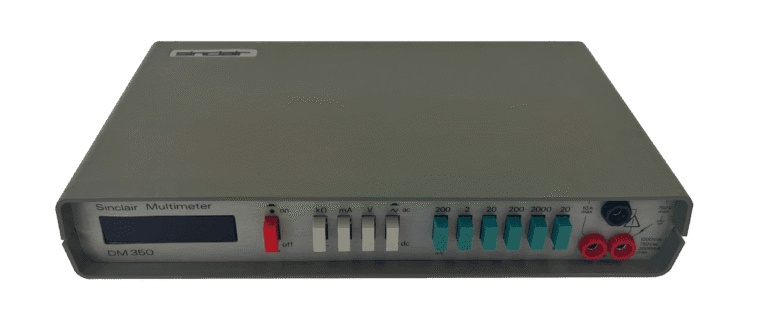
The DM350 built on the DM235’s foundation, expanding its measurement capacity to suit semi-professional users. Housed in the same understated casing, it offered settings for 34 different types or levels of electrical measurement—covering everything from low-voltage circuits to high-resistance components. This versatility made it suitable for more demanding testing tasks. Its reliability kept it in production into the 1980s, bridging the gap between Sinclair’s general-purpose meters and its high-end industrial models.

Designed for industrial use, the DM450 featured a 4½-digit LED display—allowing it to show results with greater detail than other models in the range. This higher resolution made it suitable for tasks where small variations in voltage or resistance needed to be measured precisely. Though externally similar to the DM350, its advanced capabilities placed it at the top of Sinclair’s instrument line. After Sinclair Radionics was restructured in 1979, the DM450 continued to be sold under the Thandar brand.
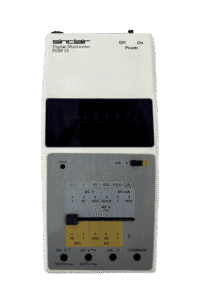
Marketed as a “personal digital multimeter,” the PDM35 marked a shift in Sinclair’s instrument range toward compact, affordable tools for field use. It reused the casing from Sinclair’s Oxford calculators, giving it the look and feel of a pocket calculator. It measured voltage, current, and resistance on an LED display, making it a practical choice for technicians, service engineers, and electronics hobbyists needing a lightweight device they could carry with them.
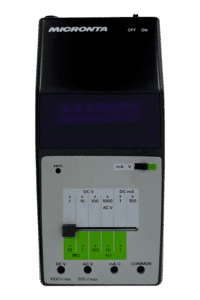
This digital multimeter shares both design and function with the Sinclair PDM35 and is believed to have been produced by Sinclair for Micronta, the in-house test equipment brand of Radio Shack. Housed in the same compact black casing used for Sinclair oxford calculators, it allowed users to measure voltage, current, and resistance. Marked “Made in England,” this example reflects how British-designed instruments reached international markets through rebranded partnerships in the late 1970s.
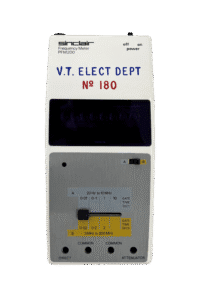
The PFM200 measured the frequency of electrical signals—an essential task in testing radios, clocks, and timing circuits. It displayed readings on an LED screen and could detect signals from 20 Hz to 200 MHz, covering everything from the slow pulses of household power to the faster signals used in broadcast and computing equipment. Like the PDM35 multimeter, it reused the casing from Sinclair’s earlier Oxford calculators, combining compactness with practicality. One of the final instruments produced under the Sinclair Radionics name, this example also carries a mark from a previous owner: “V.T. Elect. Dept. No. 180.”
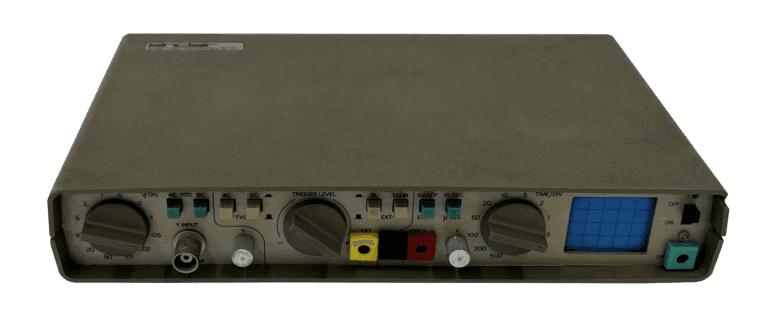
Designed for portable testing of electronic circuits, the SC110 allowed engineers to view changing electrical signals on a compact 4 cm screen. It could run on batteries or mains power, making it practical for field use as well as on the workbench. Released shortly after the British National Enterprise Board took control of Sinclair Radionics, it was one of the last products to carry the Sinclair name. Its service manual features both Sinclair and Thandar branding, reflecting the company’s transition during this period to Thandar Electronics.
